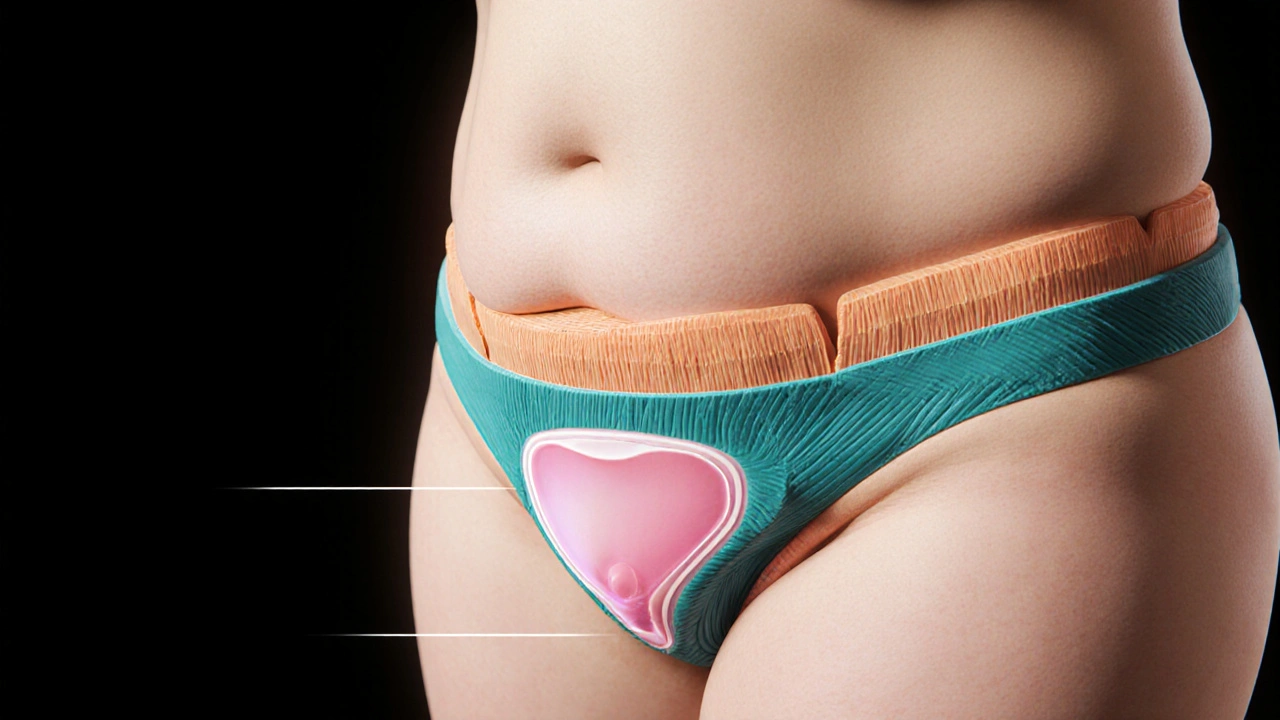Obesity & Urine Leakage Risk Calculator
Ever wondered why some people struggle with unexpected urine leakage? The connection between obesity and urine leakage is more than a coincidence. This article walks you through how extra weight presses on the urinary system, what that means for everyday life, and practical steps you can take to protect your bladder.
Key Takeaways
- Excess body weight increases pressure on the bladder and weakens pelvic floor muscles, raising the chance of urinary incontinence.
- Related health issues like diabetes and high blood pressure can worsen leakage symptoms.
- Targeted weight loss, regular pelvic floor exercises, and dietary tweaks often reduce or eliminate episodes.
- Knowing the warning signs helps you seek medical advice before problems worsen.
- Long‑term management combines lifestyle changes with professional guidance.
Understanding the link begins with a clear picture of the main players.
When it comes to obesity is a medical condition defined by an excess of body fat that poses health risks, the extra pounds don’t just sit on the surface. They press down on internal organs, especially the bladder, and can strain the muscles that keep urine in check.
Urinary incontinence is the term for any involuntary loss of urine, ranging from occasional dribbles to a full‑bladder accident. While many factors contribute, weight is a major, often overlooked, driver.
How Extra Weight Affects the Bladder
The bladder is a stretchy sac that stores urine until you’re ready to go. It sits low in the pelvis, supported by a ring of pelvic floor muscles that contract to hold urine in place. When you carry extra kilos, two things happen:
- Increased abdominal pressure: Fat around the waist pushes the diaphragm upward, raising pressure on the bladder. This constant squeeze can make the bladder feel fuller sooner, leading to frequent urges.
- Muscle fatigue: The pelvic floor has to work harder all day. Over time, the muscles weaken, much like any other muscle that’s over‑used without proper training.
Scientists measure body fat impact using body mass index (BMI), calculated by dividing weight in kilograms by height in meters squared. Studies consistently show that people with a BMI over 30 are twice as likely to develop urinary incontinence compared with those in the normal range.
Related Health Conditions That Amplify the Risk
Carrying extra weight often brings other health issues that further stress the urinary system.
- Diabetes can damage nerves that control bladder contraction, a condition called diabetic cystopathy. Nerve damage makes it harder to sense a full bladder, increasing leakage episodes.
- High blood pressure is linked to weakened blood vessels in the pelvic region, reducing oxygen flow to the muscles that support the bladder.
- Obstructive sleep apnea, common in obese individuals, leads to nighttime bathroom trips that can strain the bladder and pelvic floor.
These co‑morbidities create a perfect storm: the bladder is under pressure, the nerves that tell you when to go are dulled, and the muscles that should keep urine in are fatigued.

Spotting the Warning Signs Early
Early detection makes management easier. Look out for:
- Needing to use the restroom more than eight times a day.
- Sudden urges that are hard to control.
- Leakage during coughing, sneezing, or lifting heavy objects (known as stress incontinence).
- Dribbling after finishing a bathroom visit (often a sign of overflow incontinence).
If any of these sound familiar, a quick chat with a GP or a urologist can rule out infections, prostate issues, or other treatable conditions.
Weight‑Loss Strategies That Help the Bladder
Reducing body weight lightens the load on the bladder and gives the pelvic floor a chance to recover.
Research from the National Institute of Diabetes and Digestive and Kidney Diseases (NIDDK) found that a 5‑10% loss in body weight cut urinary incontinence episodes by about 50% in women and 30% in men.
Nutrition Tweaks
- Focus on diet rich in lean protein, whole grains, fruits, and vegetables. These foods keep you full longer, making it easier to eat less.
- Cut back on caffeine, alcohol, and carbonated drinks, which can irritate the bladder and increase urgency.
- Stay hydrated, but spread fluid intake throughout the day rather than gulping large amounts at once.
Physical Activity
Regular physical activity burns calories and improves muscle tone throughout the body. Aim for at least 150 minutes of moderate aerobic exercise per week-think brisk walking, cycling, or swimming.
Specific exercises that target the pelvic floor, often called Kegels, are essential. To do them:
- Identify the right muscles by stopping the flow of urine mid‑stream.
- Contract the muscles for a count of five, then relax for five.
- Repeat 10-15 times, three times a day.
Consistency matters; even a few weeks can show noticeable improvements in bladder control.
Medical Options When Lifestyle Changes Aren’t Enough
Sometimes, diet and exercise need a boost. Doctors can offer:
- Prescription medications that relax the bladder neck or strengthen muscle tone.
- Physical therapy with a specialist in pelvic health, who can guide more advanced exercises.
- Surgical options, such as sling procedures, for severe stress incontinence.
These interventions work best when paired with ongoing weight‑management efforts, ensuring long‑term success.
Putting It All Together: A Simple Action Plan
Here’s a step‑by‑step roadmap you can start right now:
- Track your weight and calculate your BMI. If it’s 30 or higher, you’re in the obesity range.
- Keep a bladder diary for a week: note each bathroom visit, any leaks, and fluid intake.
- Schedule a check‑up to rule out infections or other medical issues.
- Begin a calorie‑controlled diet focusing on whole foods; aim for a 5‑10% weight loss over three months.
- Incorporate 30 minutes of brisk walking most days, plus Kegel exercises three times daily.
- Reduce caffeine and alcohol, and spread water consumption evenly.
- Re‑evaluate after six weeks. If leaks persist, discuss medication or pelvic‑floor therapy with your doctor.
Stick with the plan, and you’ll likely notice fewer bathroom trips, stronger pelvic muscles, and a healthier body overall.

Frequently Asked Questions
Can losing just a few pounds actually improve urine leakage?
Yes. Studies show that shedding 5‑10% of body weight can cut incontinence episodes by half for many people.
Are Kegel exercises safe for men?
Absolutely. Men can strengthen their pelvic floor the same way women do, which helps with post‑prostate surgery leakage and general bladder control.
What foods should I avoid to reduce bladder irritation?
Caffeine, alcohol, artificial sweeteners, and highly acidic fruits or juices can trigger urgency and leaks.
Is urinary incontinence ever a sign of a serious condition?
Occasionally, it signals nerve damage, bladder infections, or prostate problems. A medical evaluation ensures any underlying issue is treated promptly.
How long does it take to see results after starting pelvic floor exercises?
Most people notice improvement within 4‑6 weeks if they practice consistently.
By understanding how weight impacts the bladder and taking proactive steps, you can reclaim confidence and avoid the embarrassment of unexpected leaks. It’s never too late to start, and every ounce lost brings you closer to a healthier, dryer life.


Terry Lim
September 30, 2025 AT 21:39People who ignore the obvious link between obesity and leaks are just lazy about their health.
Cayla Orahood
October 2, 2025 AT 15:19It's no coincidence that big pharma pushes sugar‑laden drinks while silently watching us balloon and our bladders betray us; the elite don't want us to know that shedding a few pounds could free us from the constant embarrassment.
McKenna Baldock
October 4, 2025 AT 08:59Consider the body as a delicate equilibrium; when excess weight tips the scales, the pressure upon the pelvic floor becomes a metaphor for how external burdens can destabilize inner harmony. By restoring balance through mindful nutrition and gentle exercise, we honor both physical and philosophical well‑being.
Roger Wing
October 6, 2025 AT 02:39Obesity just makes the bladder work harder
Matt Cress
October 7, 2025 AT 20:19Oh sure, because everyone loves spending extra minutes in the bathroom just cuz they ate a cheeseburger, right?
Andy Williams
October 9, 2025 AT 13:59Statistically, studies indicate that a 5‑10% reduction in body mass index correlates with a 30‑50% decrease in urinary incontinence episodes, underscoring the importance of weight management as a therapeutic strategy.
Paige Crippen
October 11, 2025 AT 07:39What if the data we’re seeing is curated to keep us dependent on pharmaceutical pads, while the real solution – losing weight – is being suppressed?
sweta siddu
October 13, 2025 AT 01:19Hey friends! 🌟 If you’re feeling the pressure (literally) try swapping soda for water and add a fun walk each day – you’ll thank your bladder later! 🚶♀️💧
Ted Mann
October 14, 2025 AT 18:59Weight gain exerts a persistent compressive force on the abdominal cavity, and this mechanical stress inevitably transmits to the bladder, reducing its functional capacity. Over time, the pelvic floor musculature, tasked with counteracting this pressure, undergoes fatigue similar to any overworked skeletal muscle. When the muscles weaken, the urethral closure mechanism falters, leading to stress incontinence during activities such as coughing or lifting. Moreover, adipose tissue secretes inflammatory cytokines that can impair neural signaling pathways governing bladder control. These biochemical changes compound the mechanical burden, creating a vicious cycle of leakage and embarrassment. Psychological stress resulting from accidental leaks can further increase cortisol levels, which in turn promotes visceral fat accumulation, deepening the problem. Breaking this feedback loop requires a multidimensional approach: dietary modification, cardiovascular exercise, and targeted pelvic floor training. Reducing caloric intake by a modest 250‑500 calories per day can initiate gradual weight loss without triggering metabolic slowdown. Incorporating high‑intensity interval training has been shown to preferentially deplete visceral fat, which directly alleviates intra‑abdominal pressure. Concurrently, practicing Kegel exercises three times daily reinforces the levator ani and pubococcygeus muscles, restoring continence confidence. Clinical evidence suggests that after six weeks of consistent effort, many individuals report a noticeable decline in nocturnal urgency. It is also advisable to monitor fluid intake patterns, favoring sip‑by‑sip consumption over large boluses that may overwhelm a compromised bladder. Consulting a uro‑therapy specialist can provide personalized feedback, ensuring that techniques are performed correctly and efficiently. Ultimately, the synergy of lifestyle changes and professional guidance offers the most robust pathway to reclaiming bladder health and overall well‑being. Stay patient, as sustainable results often emerge after several months of dedication.
Brennan Loveless
October 16, 2025 AT 12:39While most health gurus harp on calories, the real issue is that our Western diet policy discourages traditional, low‑fat cuisines that would naturally keep both waistlines and bladders in check.
Vani Prasanth
October 18, 2025 AT 06:19That’s a solid point – remember to set realistic weekly goals and celebrate each small victory, whether it’s a pound lost or a day without a leak.
Maggie Hewitt
October 19, 2025 AT 23:59Oh great, another reminder that we need to “just exercise more” – as if the gym equipment magically appears in our living rooms.
Mike Brindisi
October 21, 2025 AT 17:39Listen you need to track every snack and pee log you’ll see the pattern faster
Elizabeth Nicole
October 23, 2025 AT 11:19Hey team, you’ve got the power to turn this around! Start small: swap one sugary drink for water today, add a 10‑minute walk, and do a quick set of Kegels before bed. Each tiny habit builds momentum, and before you know it, you’ll notice fewer trips to the bathroom and a lighter feeling overall. Keep it up, you’re doing amazing!
Dany Devos
October 25, 2025 AT 04:59While enthusiasm is commendable, it is essential to ground recommendations in peer‑reviewed research to avoid disseminating anecdotal advice.
Sam Matache
October 26, 2025 AT 22:39Seriously, the drama of dealing with leaks at a party is something out of a nightmare – you can’t even enjoy the music without worrying about a soggy surprise.
Hardy D6000
October 28, 2025 AT 16:19Exactly why I recommend a structured regimen: calculate your basal metabolic rate, reduce intake by 10%, and schedule pelvic floor sessions thrice weekly – any deviation will stall progress.
Amelia Liani
October 30, 2025 AT 09:59I hear you, the fear of a sudden leak can feel like a shadow hanging over every outing, but please know you’re not alone; many have walked this path, and with consistent care, relief is achievable and life can feel bright again.